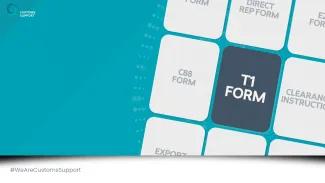What is a T1 document?
A T1 document is used for moving goods across borders without completing an import clearance, meaning that you don’t need to pay import duty and VAT until the goods arrive at the destination.
The use of T1 forms has grown since Brexit as the UK is no longer within the EU customs territory. A T1 transit document is now an essential accompaniment to your shipments that are destined to go further inland than France or another sea border of the EU.
How does the T1 transit procedure work?
The T1 transit procedure is begun by the exporting customs broker, who is liable for the payment of duty and VAT. This is so that taxes can be levied on your goods by any transit country if the procedure is not completed at the destination, preventing the misuse of T1 forms to bypass paying taxes.
To obtain a T1 customs form, your customs broker will first need to complete the declaration electronically on NCTS. Then, your haulier will present your goods to the border force for authorisation and be presented with a T1 customs document.
Once the T1 procedure is live, a copy of the T1 form must travel with the goods at all times so that an inspecting customs officer can identify the goods are travelling under transit.
T1 customs forms are closed off at the destination by presenting your goods to a border agency. The import clearance agent will also declare the T1 document on their declaration so that there is a record that the duty and VAT have been paid.
What is needed to create T1 forms?
T1 forms are created using the same documentation that is required for an export customs clearance (commercial invoice, packing list, and transport documentation are the minimum).
Your customs broker will be able to process both the export declaration and the T1 form, provided that they have a customs guarantee that authorises them to raise T1 customs documents. If your T1 procedure is not closed at the destination, it will be the guaranteed party who is contacted and liable for the taxes.
Note that customs only guarantee companies up to a certain amount, meaning that outstanding procedures are a drain on their availability and may temporarily prevent future shipments from being guaranteed.
At Customs Support, we have links to all ports and authorisation to complete T1 documents, amongst other specialist processes.
How long do I have to close off a T1 customs form?
Once a T1 form has gone live, it is expected to be closed off within 2-3 weeks. After this, customs will begin the process of reclaiming the outstanding duty and VAT from your customs broker.
During stage one of the reclaim, the Central Community Transit Office (CCTO) will send a notice to your customs broker that they need evidence that the T1 procedure has been completed so that they can close the T1 customs form on NCTS.
One month after the stage one notice, the CCTO will issue a “Right to be heard” notice, which gives you another month to produce evidence that the T1 procedure has been completed.
If evidence has not been received by the end of this month, your customs broker will be issued with a C18 payment demand for the duty and VAT that is owed on the shipment.
Customs Support are here for your T1 form requirements – from start to finish
Customs Support completes T1 transit procedures for exporters just like you throughout the UK and has significantly expanded our guarantee over the last couple of years to accommodate your shipments.
Supporting you with both your T1 forms and end-to-end customs clearance, we ensure you remain compliant when moving your goods under a transit procedure. Contact us for more information today.














